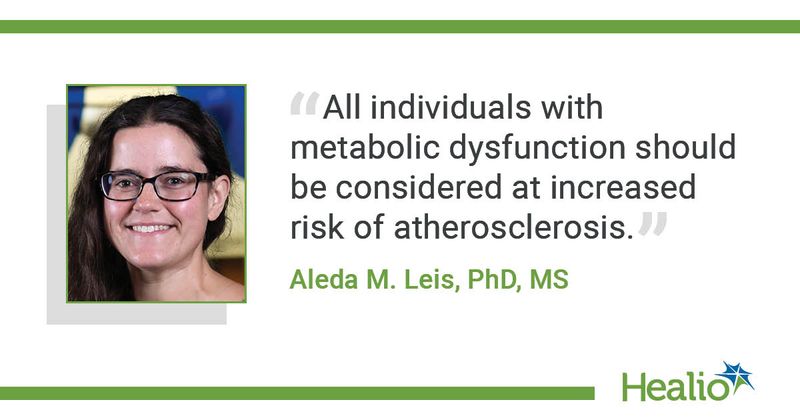Metabolic syndrome linked to higher carotid artery thickness for women, regardless of BMI
Key takeaways:
- Women with metabolic syndrome have greater carotid artery thickness than those without the condition.
- Providers should monitor all women with metabolic syndrome for atherosclerosis, regardless of BMI.
Women with metabolic syndrome are more likely to have increased risk for atherosclerotic changes than women without metabolic syndrome, regardless of whether they also have obesity, according to study findings published in Menopause.
“All individuals with metabolic dysfunction should be considered at increased risk of atherosclerosis,” Aleda M. Leis, PhD, MS, research investigator in the department of epidemiology at the University of Michigan School of Public Health, told Healio. “Clinicians treating normal-weight individuals with metabolic dysfunction should monitor them for atherosclerotic changes as they would those with obesity and metabolic dysfunction. Given the known risk of developing metabolic syndrome and constituent components during the menopausal transition, these findings within this population are particularly important.”

Leis and colleagues obtained data from 1,433 women who participated in the Study of Women’s Health Across the Nation (SWAN) and completed a carotid ultrasound assessment during the study’s visit 12 follow-up from 2009 to 2011 or the visit 13 follow-up from 2011 to 2013 (mean age, 60.1 years). Carotid artery ultrasound images were taken to measure carotid artery intima-media thickness and adventitial diameter. Women were defined as having metabolic syndrome if they had three or more of the following: high waist circumference, high fasting blood glucose, high blood pressure, low HDL cholesterol and high fasting triglycerides. Women with a BMI of 30 kg/m2 or higher were identified as having obesity.
Of the participants, 44.1% had obesity and 34.8% had metabolic syndrome. The proportion of women with neither condition was 45.6%, and 24.5% of women had both conditions.
Women with metabolic syndrome had a mean maximum carotid artery intima-media thickness of 0.959 mm and those with obesity had a mean carotid artery intima-media thickness of 0.947 mm compared with a carotid artery intima-media thickness of 0.88 mm for those without obesity and metabolic syndrome (P < .001). Mean adventitial diameter was 7.367 mm for women with metabolic syndrome and 7.248 mm for women with obesity compared with 6.993 mm for those with neither condition (P < .001).
In the fully-adjusted model, women with obesity and metabolic syndrome had a 0.009 mm higher predicted carotid artery intima-media thickness than those with metabolic syndrome alone and a 0.025 mm higher predicted carotid artery intima-media thickness than women with obesity alone. Black women had a 0.062 mm higher carotid artery intima-media thickness than white women (P < .001). No difference in carotid artery intima-media thickness was observed between white women and Hispanic or Chinese women.
Women with metabolic syndrome and obesity had a model-adjusted predicted mean adventitial diameter 0.123 mm higher than women with metabolic syndrome alone and 0.208 mm higher than those with obesity alone. Black women had a 0.212 mm larger adventitial diameter and Chinese women had a 0.229 mm greater adventitial diameter compared with white women (P < .001 for both).
The researchers wrote that there was no synergistic interaction observed between obesity and metabolic syndrome in the findings.
“Having obesity in combination with metabolic syndrome did not result in a significantly worse carotid intima-media thickness or adventitial diameter parameters than those who had metabolic syndrome alone,” Leis said. “This suggests that there is no additional effect of having obesity with metabolic syndrome on measures of subclinical atherosclerosis.”
Leis said more studies are needed to examine whether certain conditions within metabolic syndrome are causing higher carotid artery intima-media thickness and adventitial diameter for women.
For more information:
Aleda M. Leis, PhD, MS, can be reached at aledat@umich.edu.
